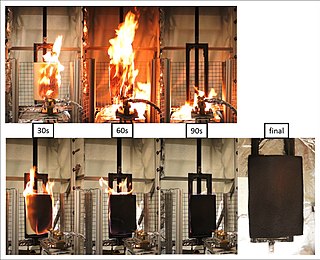
Bromine is a chemical element; it has symbol Br and atomic number 35. It is a volatile red-brown liquid at room temperature that evaporates readily to form a similarly coloured vapour. Its properties are intermediate between those of chlorine and iodine. Isolated independently by two chemists, Carl Jacob Löwig and Antoine Jérôme Balard, its name was derived from Ancient Greek βρῶμος (bromos) 'stench', referring to its sharp and pungent smell.

Tetraethyllead (commonly styled tetraethyl lead), abbreviated TEL, is an organolead compound with the formula Pb(C2H5)4. It was widely used as a fuel additive for much of the 20th century, first being mixed with gasoline beginning in the 1920s. This "leaded gasoline" had an increased octane rating that allowed engine compression to be raised substantially and in turn increased vehicle performance and fuel economy. TEL was first synthesised by German chemist Carl Jacob Löwig in 1853. American chemical engineer Thomas Midgley Jr., who was working for the U.S. corporation General Motors, was the first to discover its effectiveness as an antiknock agent in 1921, after spending several years attempting to find an additive that was both highly effective and inexpensive.

1,2-Dibromoethane, also known as ethylene dibromide (EDB), is an organobromine compound with the chemical formula C
2H
4Br
2. Although trace amounts occur naturally in the ocean, where it is probably formed by algae and kelp, substantial amounts are produced industrially. It is a dense colorless liquid with a faint, sweet odor, detectable at 10 ppm. It is a widely used and sometimes-controversial fumigant. The combustion of 1,2-dibromoethane produces hydrogen bromide gas that is significantly corrosive.

Methyl tert-butyl ether (MTBE), also known as tert-butyl methyl ether, is an organic compound with a structural formula (CH3)3COCH3. MTBE is a volatile, flammable, and colorless liquid that is sparingly soluble in water. Primarily used as a fuel additive, MTBE is blended into gasoline to increase its octane rating and knock resistance, and reduce unwanted emissions.
Polybrominated diphenyl ethers or PBDEs, are a class of organobromine compounds that are used as flame retardants. Like other brominated flame retardants, PBDEs have been used in a wide array of products, including building materials, electronics, furnishings, motor vehicles, airplanes, plastics, polyurethane foams, and textiles. They are structurally akin to polychlorinated diphenyl ethers (PCDEs), polychlorinated biphenyls (PCBs) and other polyhalogenated compounds, consisting of two halogenated aromatic rings. PBDEs are classified according to the average number of bromine atoms in the molecule. The life-saving benefits of fire retardants led to their popularization. Standards for mass transit vehicles continues to increase as of 2021.

Flame retardants are a diverse group of chemicals that are added to manufactured materials, such as plastics and textiles, and surface finishes and coatings. Flame retardants are activated by the presence of an ignition source and prevent or slow the further development of flames by a variety of different physical and chemical mechanisms. They may be added as a copolymer during the polymerisation process, or later added to the polymer at a moulding or extrusion process or applied as a topical finish. Mineral flame retardants are typically additive, while organohalogen and organophosphorus compounds can be either reactive or additive.

Ethyl Corporation is a fuel additive company headquartered in Richmond, Virginia, in the United States. The company is a distributor of fuel additives. Among other products, Ethyl Corporation distributes tetraethyl lead, an additive used to make leaded gasoline.
A bromide ion is the negatively charged form (Br−) of the element bromine, a member of the halogens group on the periodic table. Most bromides are colorless. Bromides have many practical roles, being found in anticonvulsants, flame-retardant materials, and cell stains. Although uncommon, chronic toxicity from bromide can result in bromism, a syndrome with multiple neurological symptoms. Bromide toxicity can also cause a type of skin eruption, see potassium bromide. The bromide ion has an ionic radius of 196 pm.
Brominated flame retardants (BFRs) are organobromine compounds that have an inhibitory effect on combustion chemistry and tend to reduce the flammability of products containing them. The brominated variety of commercialized chemical flame retardants comprise approximately 19.7% of the market. They are effective in plastics and textile applications like electronics, clothes, and furniture.

A fire retardant is a substance that is used to slow down or stop the spread of fire or reduce its intensity. This is commonly accomplished by chemical reactions that reduce the flammability of fuels or delay their combustion. Fire retardants may also cool the fuel through physical action or endothermic chemical reactions. Fire retardants are available as powder, to be mixed with water, as fire-fighting foams and fire-retardant gels. Fire retardants are also available as coatings or sprays to be applied to an object.

Albemarle Corporation is an American specialty chemicals manufacturing company based in Charlotte, North Carolina. It operates 3 divisions: lithium, bromine specialties and catalysts.

Lanxess AG is a German specialty chemicals company based in Cologne, Germany that was founded in 2004, via the spin-off of the chemicals division and parts of the polymers business from Bayer AG.

Decabromodiphenyl ether is a brominated flame retardant which belongs to the group of polybrominated diphenyl ethers (PBDEs). It was commercialised in the 1970s and was initially thought to be safe, but is now recognised as a hazardous and persistent pollutant. It was added to Annex A of the Stockholm Convention on Persistent Organic Pollutants in 2017, which means that treaty members must take measures to eliminate its production and use. The plastics industry started switching to decabromodiphenyl ethane as an alternative in the 1990s, but this is now also coming under regulatory pressure due to concerns over human health.

Chemtura Corporation was a global corporation headquartered in Philadelphia, Pennsylvania, United States, with its other principal executive office in Middlebury, Connecticut. Merged into Lanxess in 2017, the company focused on specialty chemicals for various industrial sectors, and these were transportation, energy, and electronics. Chemtura operated manufacturing plants in 11 countries. Its primary markets were industrial manufacturing customers. The corporation employed approximately 2500 people for research, manufacturing, logistics, sales and administration. Operations were located in North America, Latin America, Europe and Asia. In addition, the company had significant joint ventures primarily in the United States. For the year ended December 31, 2015, the company's global core segment revenue was $1.61 billion. Chief executive officer was Craig A. Rogerson, who was also the president and chairman of the board of Chemtura Corporation. On April 21, 2017, Chemtura was acquired by the German chemical company Lanxess.
Crompton Corporation was a chemical research, production, sales and distribution company headquartered in Middlebury, Connecticut. The company produced specialty chemicals used for polymers, fire suppressants and retardants, pool and spa water purification systems and various other applications. In 2005, Crompton merged with Great Lakes Chemical Corporation to become Chemtura.
Organobromine chemistry is the study of the synthesis and properties of organobromine compounds, also called organobromides, which are organic compounds that contain carbon bonded to bromine. The most pervasive is the naturally produced bromomethane.

Hexabromobenzene is an aryl bromide and a six-substituted bromobenzene in which all six positions of the central benzene ring are bonded to a bromine atom.
Bromine production in the United States of 225,000 tonnes in 2013 made that country the second-largest producer of bromine, after Israel. The US supplied 29 percent of world production. Since 2007, all US bromine has been produced by two companies in southern Arkansas, which extract bromine from brine pumped from the Smackover Formation. At an advertised price of US$3.50 to US$3.90 per kg, the US 2013 US production would have a value of roughly US$800 million.

Bis(2-ethylhexyl)tetrabromophthalate (or TBPH), is a brominated phthalate derivative with the formula C24H34Br4O4 commonly used as a brominated flame retardant (BFR).












